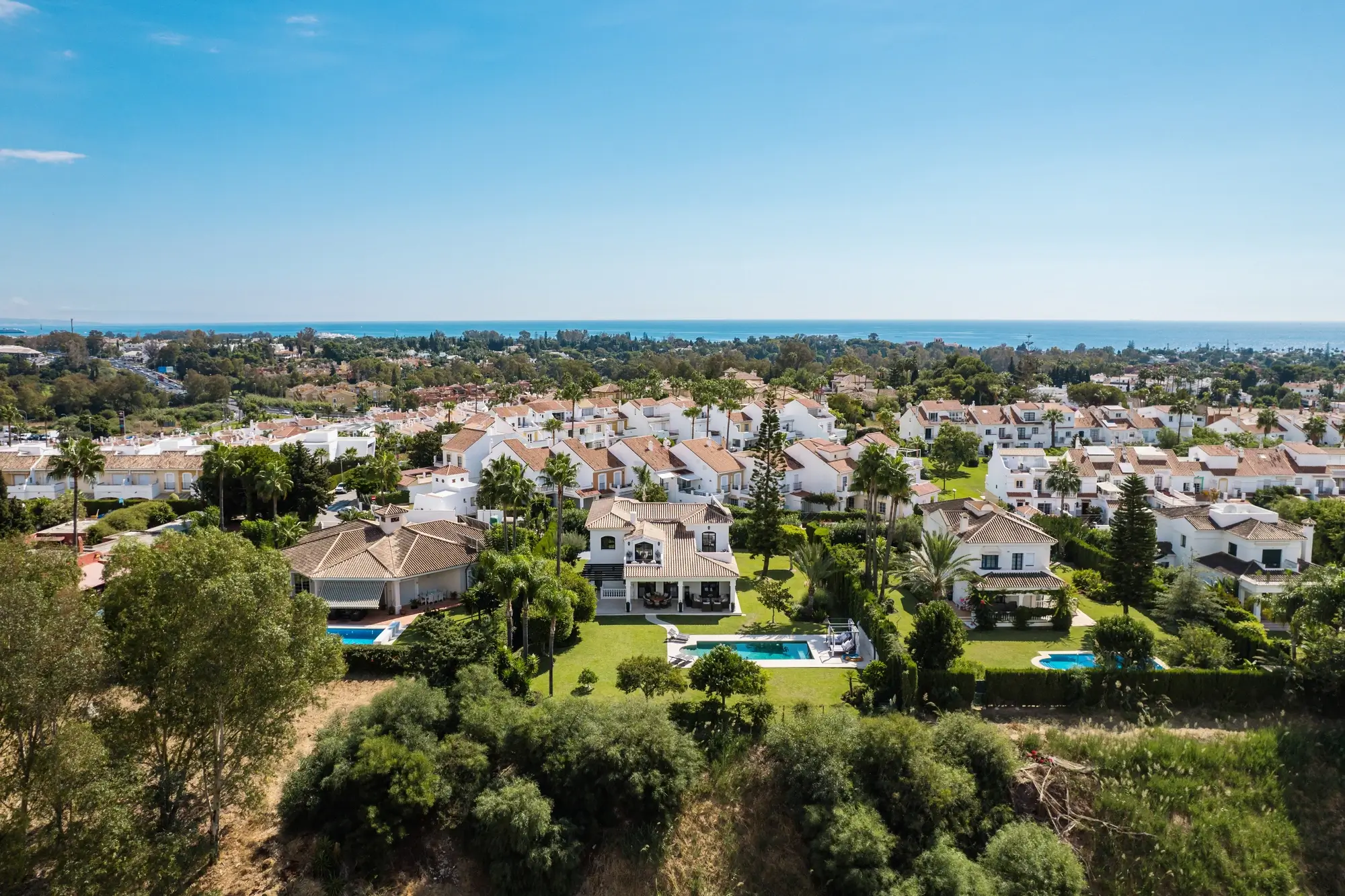An In-Depth Analysis of Marbella’s International Buyer Landscape
The Spanish luxury real estate market has undergone a remarkable transformation in recent years, with international buyers now commanding an unprecedented share of high-end property transactions.
Executive Summary
The Spanish luxury real estate market has undergone a remarkable transformation in recent years, with international buyers now commanding an unprecedented share of high-end property transactions. While foreign buyers represent approximately 20% of Spain’s overall property market, this figure rises dramatically in the premium segment, where international investors account for over 90% of luxury home purchases in prime locations such as Marbella, Ibiza, and select areas of Madrid and Barcelona.
This comprehensive analysis examines the factors driving this phenomenon, identifies key buyer demographics, and explores the implications for property values, market dynamics, and investment strategies in Spain’s most prestigious real estate markets, with a specific focus on Marbella’s evolving landscape.
The Unprecedented Rise of International Investment
The dominance of foreign buyers in Spain’s luxury property sector represents the culmination of a long-term trend that has accelerated significantly since the post-pandemic recovery. While foreign buyers have traditionally played an important role in Spain’s coastal markets, their share of premium transactions has reached new heights, transforming the upper echelons of the market.
According to the latest data from Spain’s College of Registrars, foreign buyers acquired nearly 93,000 properties across Spain in 2024, representing 14.6% of all transactions nationwide. However, this figure masks the extreme concentration of international investment in luxury segments and specific geographic areas.
In the Balearic Islands, foreign buyers accounted for 32.6% of all transactions, while in the Valencian Community and Canary Islands, they represented 28.9% and 27.2% respectively. When examining properties valued above €3 million, the international buyer share increases dramatically across all prime locations.
Marbella: The Epicenter of International Luxury Investment
Marbella and the broader Costa del Sol region have emerged as the undisputed epicenter of international luxury real estate investment in mainland Spain. The area’s combination of climate, infrastructure, international schools, healthcare facilities, and global accessibility has created a perfect environment for high-net-worth individuals seeking both lifestyle enhancement and investment security.
Recent market data reveals several key insights into Marbella’s luxury property landscape:
- Average Price Point: The mean value of luxury properties in Málaga province stands at €5,253,702, with an average value per square meter of €7,185.24 in 2025
- Growth Trajectory: Prime property values in Marbella have seen annual increases of 3.17% for homes valued above €3 million
- Transaction Volume: In the first half of 2025, one leading luxury agency alone reported 38 sales totaling over €143 million, with an average sale price of €3.76 million
- International Dominance: Of these transactions, 68% involved international buyers, representing 17 different nationalities
The concentration of international buyers becomes even more pronounced at the ultra-luxury level. Properties priced above €10 million in areas such as La Zagaleta, Sierra Blanca, and beachfront locations in the Golden Mile and Los Monteros show foreign buyer percentages exceeding 95%, with British, German, Dutch, and increasingly, American and Middle Eastern buyers leading acquisitions.
Buyer Demographics and Nationality Trends
The nationality profile of foreign buyers in Spain’s luxury market has diversified significantly in recent years, though certain nationalities continue to dominate specific segments and locations.
Leading Nationalities in Marbella’s Luxury Market
- British: Despite Brexit-related challenges, British buyers remain the largest single nationality group in Marbella’s luxury market, accounting for approximately 15% of international purchases above €2 million. Their presence has remained remarkably stable over the past two years.
- German: German buyers have shown consistent and growing interest in Marbella’s premium properties, focusing particularly on modern, energy-efficient homes with smart technology integration.
- Dutch: Buyers from the Netherlands have emerged as a major force, representing 8.2% of foreign luxury purchases nationwide, with even higher concentrations in Marbella’s premium developments.
- Scandinavian: Swedish, Norwegian, and Danish buyers continue to favor contemporary architectural styles and sustainable features, predominantly in hillside locations with panoramic views.
- North American: Perhaps the most significant shift in recent years has been the surge in American buyers, who now represent 10.4% of foreign purchases in the premium segment. This group typically focuses on larger properties and branded residences.
- Middle Eastern: Buyers from the UAE, Saudi Arabia, and Qatar have increased their presence in the ultra-luxury segment, often seeking privacy, security, and substantial plot sizes.
Emerging Nationality Trends
While traditional European markets continue to dominate, several emerging buyer groups are reshaping the landscape:
- Polish investors have shown remarkable growth, with transactions exceeding 4,200 across Spain in 2024
- Latin American buyers, particularly from Mexico and Colombia, have increased their share of luxury purchases, often driven by political and economic considerations in their home countries
- Chinese investment, though numerically smaller at around 3,000 transactions, tends to focus on higher-value properties
Motivations and Purchasing Patterns
The motivations driving foreign investment in Spain’s luxury market have evolved significantly, with several clear patterns emerging:
Primary vs. Secondary Residence
The traditional second-home buyer model is giving way to a more complex landscape. While in 2015, 51% of foreign buyers were non-resident second home owners, by 2024 this had dropped to 41%, indicating a shift toward permanent or semi-permanent relocation.
This trend is particularly evident among British buyers. Two decades ago, 77% of British purchasers were second home owners; today, that figure has fallen to 60%, with 40% classified as resident foreign owners.
Lifestyle Integration and Remote Work
The pandemic permanently altered work patterns for many high-net-worth individuals, enabling location flexibility that continues to benefit Spanish luxury markets. International buyers increasingly seek properties that accommodate professional needs alongside lifestyle preferences, with high-speed internet connectivity, dedicated office spaces, and proximity to international transport links now essential considerations.
Investment Diversification and Wealth Preservation
Economic and political uncertainty in various regions has reinforced Spain’s appeal as a safe haven for capital. Foreign buyers frequently cite investment diversification and wealth preservation as key motivations, with Spain’s stable legal framework, EU membership, and relatively attractive taxation making it particularly appealing compared to alternative locations.
Impact on Local Market Dynamics
The dominance of international buyers in Spain’s luxury segment has created several notable market effects:
Price Premiums and Market Segmentation
Properties that specifically cater to international preferences command significant price premiums. In Marbella, developments and residences designed to international standards with contemporary styling, energy efficiency, and premium amenities can achieve valuations 15-20% higher than comparable properties targeting the domestic market.
This has led to increased market segmentation, with distinct property types, price points, and marketing strategies emerging for international versus domestic buyers.
Development Trends and Product Evolution
Developers have responded to international demand by creating increasingly specialized products. Branded residences—properties developed in association with premium hospitality or lifestyle brands—now represent one of the fastest-growing segments in Marbella’s luxury market, typically commanding price premiums of 25-35% compared to equivalent non-branded properties.
Similarly, new developments increasingly emphasize sustainability features, technology integration, and community amenities designed to appeal specifically to international preferences.
Supply-Demand Imbalance
The luxury market faces a persistent supply-demand imbalance, particularly in prime coastal locations. Limited land availability, regulatory constraints, and construction capacity limitations have restricted new supply, placing upward pressure on prices.
In Marbella specifically, the average discount from asking price for luxury properties was approximately 10% in early 2025, though this is expected to decrease to under 6% by 2026 as the market continues to strengthen.
Regional Comparison and Competitive Analysis
While Marbella remains the flagship destination for luxury lifestyle-led investments in mainland Spain, it faces competition from several other premium markets:
Balearic Islands
The Balearic Islands, particularly Ibiza and parts of Mallorca, continue to attract similar buyer profiles with comparable price points. Foreign buyers account for 32.6% of all transactions in the Balearics, the highest percentage in Spain, with an even higher concentration in the luxury segment.
Madrid and Barcelona
Urban luxury markets in Madrid and Barcelona cater to a different international buyer profile, typically focusing on individuals seeking primary residences with business connections to Spain. While international buyers represent a smaller percentage of overall transactions in these cities, they dominate specific premium neighborhoods and new developments.
Emerging Luxury Markets
Several emerging luxury destinations, including Estepona, Sotogrande, and parts of Costa Brava, are attracting increased international interest. These locations often offer perceived value opportunities compared to established markets like Marbella, though they typically lack the comprehensive infrastructure and service ecosystem that distinguishes prime locations.
Future Outlook and Market Projections
The outlook for international investment in Spain’s luxury real estate market remains robust, with several key trends likely to shape future developments:
Continued Price Appreciation
Market analysts project that Marbella’s luxury segment will see continued price appreciation of 3-5% annually over the next three years, with premium and ultra-premium properties outperforming the broader market.
Evolving Buyer Demographics
The nationality mix of foreign buyers is expected to continue diversifying, with American, Middle Eastern, and select Latin American buyers increasing their market share. These groups typically favor larger properties and higher price points than traditional European buyers.
Product Innovation and Specialization
Developers will increasingly focus on specialized products designed for specific international buyer segments, with branded residences, wellness-oriented communities, and sustainable luxury developments gaining market share.
Supply Constraints and Land Scarcity
Limited availability of prime development land will continue to constrain supply, particularly in established luxury enclaves. This dynamic will likely maintain upward pressure on prices while encouraging renovation and redevelopment of existing properties.
Conclusion: Investment Implications and Strategic Considerations
The dominance of international buyers in Spain’s luxury real estate market, particularly in Marbella and other prime coastal locations, represents both opportunities and challenges for various stakeholders:
For Investors
The continued influx of international capital suggests strong potential for long-term value appreciation in prime locations, particularly for properties that align with evolving international preferences. Investors should focus on locations with established international appeal, limited supply potential, and comprehensive lifestyle infrastructure.
For Developers
Successfully addressing the international market requires deep understanding of evolving buyer preferences across different nationality groups. Developers who can create specialized products targeting specific international segments—whether through design, amenities, service offerings, or branding—are likely to achieve significant price premiums.
For Local Market Participants
The internationalization of Spain’s luxury market creates opportunities for complementary businesses and services catering to foreign owners and residents. From property management and concierge services to specialized legal and financial advisory, the ecosystem surrounding international ownership continues to expand.
As Spain’s luxury real estate market evolves, the interplay between international demand, limited supply, and changing buyer preferences will continue to reshape the landscape. For Marbella specifically, its established position as a premier international destination, combined with constrained development potential and comprehensive lifestyle infrastructure, suggests continued strong performance in the luxury segment, with international buyers remaining the dominant force driving market dynamics.
For more information about international investment opportunities in Marbella’s luxury real estate market, contact Marbella Prestige at www.marbellaprestige.realestate.
Thank you for reading: Foreign Investment Dominates Spain’s Luxury Real Estate Market




